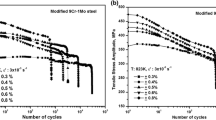Abstract
This study deals with simulation of low-cycle fatigue (LCF), followed by evaluation of fatigue parameters, which would be suitable for estimating fatigue lives under uniaxial loading. The cyclic elastic–plastic stress–strain responses were analyzed using the incremental plasticity procedures. Finite-element (FE) simulation in elastic–plastic regime was carried out in FE package ABAQUS. Emphasis has been laid on calibration of SS 316 stainless steel for LCF behavior. For experimental verifications, a series of low-cycle fatigue tests were conducted using smooth, cylindrical specimens under strain-controlled, fully reversed condition in INSTRON UTM (Universal Testing Machine) with 8,800 controller at room temperature. The comparisons between numerical simulations and experimental observations reveal the matching to be satisfactory in engineering sense. Based on the cyclic elastic–plastic stress–strain response, both from experiments and simulation, loop areas, computed for various strain amplitude, have been identified as fatigue damage parameter. Fatigue strain life curves are generated for fatigue life prediction using Coffin–Manson relation, Smith–Watson–Topper model, and plastic energy dissipated per cycle (loop area). Life prediction for LCF has been found out to be almost identical for all these three criteria and correlations between predicted and experimental results are shown. It is concluded that the improvement of fatigue life prediction depends not only on the fatigue damage models, but also on the accurate evaluations of the cyclic elastic–plastic stress/strain responses.













Similar content being viewed by others
Abbreviations
- σ:
-
Stress at any instant of time
- ε:
-
Strain at any instant of time
- σ min :
-
Minimum stress in a repeated stress cycle
- σ max :
-
Maximum stress in a repeated stress cycle
- σ m :
-
Mean stress
- σ y :
-
Yield stress
- Δσ :
-
Total stress range
- Δε:
-
Total strain range
- Δεe :
-
Total elastic strain range (elastic strain component)
- Δεp :
-
Total plastic strain range (plastic strain component)
- N (or, Nf):
-
Number of cycles to failure
- \( \sigma_{\text{f}}\, (or,\sigma_{\text{f}}^{\prime} ) \) :
-
Fatigue strength coefficient
- b:
-
Fatigue strength exponent
- \( \varepsilon_{\text{f}} \,(or,\varepsilon_{\text{f}}^{\prime} ) \) :
-
Fatigue ductility coefficient
- c (or, m):
-
Fatigue ductility exponent
- n′:
-
Cyclic strain hardening exponent
- K :
-
Cyclic strength coefficient
- σ 1, σ 2, σ 3 :
-
Principal stresses
- Y:
-
Yield stress in tension
- f:
-
Yield function
- σ ij :
-
Stress tensor
- S ij :
-
Deviatoric component of stress tensor σ ij
- α ij :
-
Back stress tensor
- \( \varepsilon_{ij}^{p} \) :
-
Plastic strain tensor
- σ 0, σ c, σ yc :
-
Current yield stress
- \( \varepsilon_{\text{eq}}^{\text{p}} \) :
-
Equivalent plastic strain
- \( R\,(\varepsilon_{\text{eq}}^{\text{p}} ) \) :
-
Isotropic hardening function (a function of \( \varepsilon_{\text{eq}}^{\text{p}} \))
- b :
-
A material constant (determines the rate of change of size of the yield surface with \( \varepsilon_{\text{eq}}^{\text{p}} \))
- Q (or, Q∞):
-
A material constant (representative of the maximum change in size of the yield surface)
- C:
-
Initial kinematic hardening modulus
- γ:
-
Dynamic recovery term associated with non-linear kinematic hardening
- H:
-
Plastic hardening modulus
- \( \dot{\varepsilon }_{\text{eq}}^{\text{p}} \) :
-
Equivalent plastic strain rate
- E ijkl :
-
Fourth-order elastic modulus tensor
- D ijkl :
-
Fourth-order elasto-plastic modulus tensor
- ν :
-
Poisson’s ratio
- σmax (or, σpeak):
-
Maximum tensile stress
- σ a,rev :
-
Fully reversed stress amplitude
- εa,rev :
-
Fully reversed strain amplitude
- W f :
-
Total plastic strain energy dissipated prior to failure
- ΔW :
-
Average plastic strain energy dissipated per cycle
References
Sandusky DW, Okada T, Saito T (1990) Mater Perform 29:66
Singh PK, Bhasin V, Vaze KK, Ghosh AK, Kushwaha HS (2008) Structural integrity of main heat transport system piping of AHWR. Health Safety and Environment Group, BARC, Mumbai, India
Wong YK, Hu XZ, Norton MP (2001) J Test Eval Am Soc Test Mater 29:138
Martin-Meizoso A, Rodriguez-Ibabe JM, Fuentes-Perez M (1993) Int J Fract 64:R45
Fatemi A, Yang L (1998) Int J Fatigue 20:9
Ganesh Sundara Raman S, Radhakrishnan VM (2002) Mater Des 23(3):249
Zeigler H (1959) Q Appl Mech 17:55
Chen WR, Keer LM (1991) An application of incremental plasticity theory to fatigue life prediction of steels. J Eng Mater Technol 113:404
Chaboche JL, Nouailhas D (1989) Trans ASME 111:384
Chaboche JL (1986) Int J Plast 2:149
Author information
Authors and Affiliations
Corresponding author
Rights and permissions
About this article
Cite this article
Dutta, A., Dhar, S. & Acharyya, S.K. Material characterization of SS 316 in low-cycle fatigue loading. J Mater Sci 45, 1782–1789 (2010). https://doi.org/10.1007/s10853-009-4155-7
Received:
Accepted:
Published:
Issue Date:
DOI: https://doi.org/10.1007/s10853-009-4155-7




